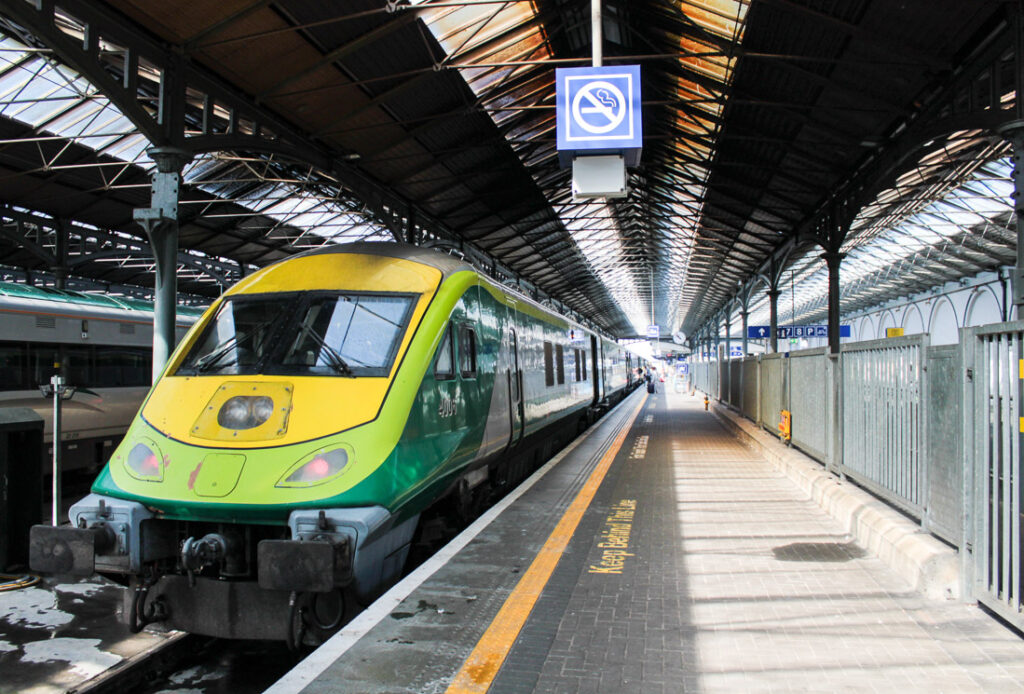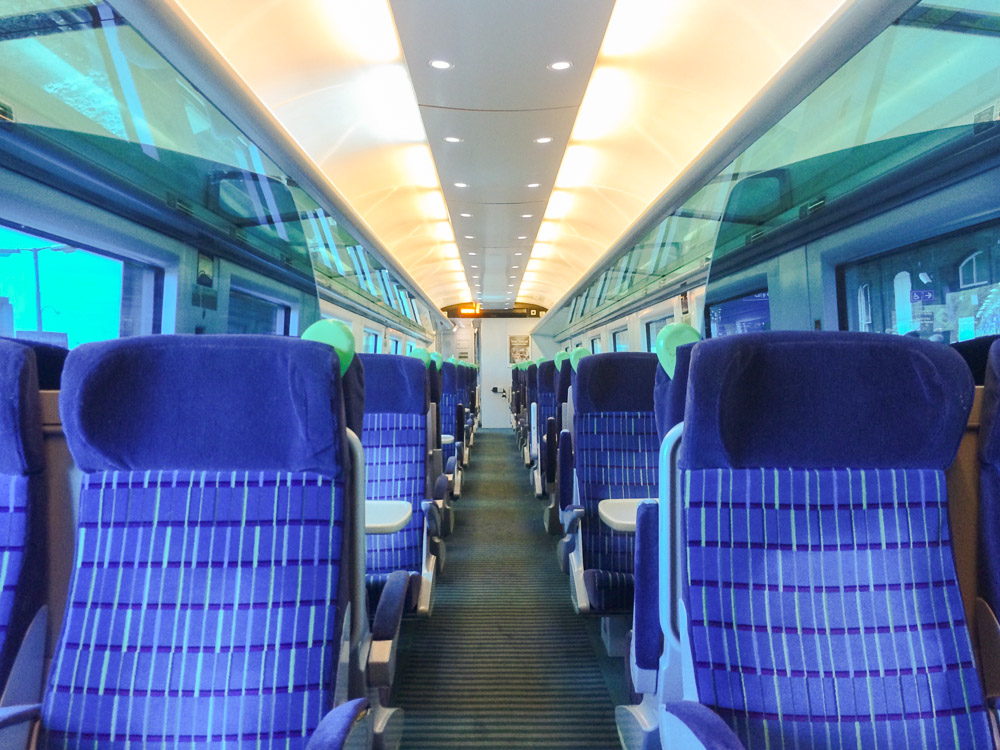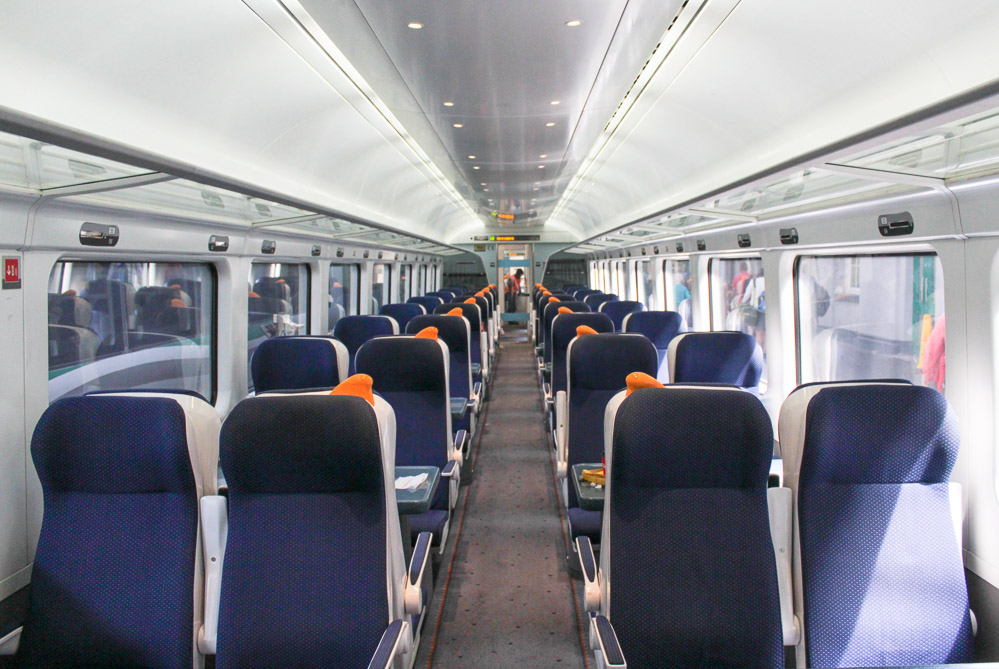The Dublin-Cork line is one of the most important railway lines in Ireland. It connects Dublin to Cork, the State’s second most important city. With the exception of the Enterprise service to Belfast, this is Irish Rail’s flagship intercity service, featuring dedicated and specially built rolling stock capable of running up to 200km/h.
But the service in practice is barely a High Speed service, running only up to a maximum of 160km/h due to signalling and locomotive limitations. Nonetheless, this is still enough for trains to cover the distance between Dublin and Cork in 2 hours and 30 minutes – a reasonable length of travel time.
The Dublin-Cork line was high on my list of must-tries, and Cork was also high on my list of must-visits, which meant it became part of my summer trip to Ireland.
First posted 20 June 2018. Updated 12 March 2023.
Departure experience at Dublin Heuston Station
The Dublin-Cork line starts at Heuston station, Dublin’s main intercity station for all services to the rest of the country excepting Sligo and the North. It is also a lot more pleasant and usable than Connolly, with transparent panels interspersed amongst the roof panels, installed during a refurbishment of the station in 2002. This led to a very nice amount of sunlight filling the platforms and concourse, providing a welcoming impression.

Having collected my tickets from the ticket machines I then made my way through the platform gates. A nice bit about Irish train travel compared to British ones is that platform numbers are displayed up to 30 minutes before departure, compared to 10 minutes in Britain. This guarantees an orderly (and leisurely) boarding process and a lack of a crowd around the information board, compared to the mad rush that is the experience in Britain. This gave me enough time to leisurely stroll onto the train, secure my luggage, and to walkabout on the platform snapping pictures. Takes the stress out of the traveling, really.

I caught my first glimpse of our train – a 6 car set hauled by a GEC Alsthom Class 201 locomotive on one end, with a DVT on the other end. The DVT is also aerodynamically optimised, though it does seem a bit odd having a streamlined design for a train that only runs at a maximum of 160km/h regularly. Of course, this train is actually designed for 200km/h so the cab design is clearly meant for those speeds.
The passenger carriages, on the other hand, are Mark 4 coaches built by CAF, not to be confused with British Mark 4 carriages.


Cabin & Onboard Amenities
The interior is a step up compared to the usual Class 22000 intercity DMUs, but features similar corporate design cues. The main difference is in the seats they feature slightly bigger legroom, have more comfortable seatbacks, and have a headrest. In comparison the seats on the Class 22000s are spartan and hard, but this is explained by the fact that the DMUs are also meant for regional services serving local stops with lower passenger dwell times.
In comparison the Mark 4 sets are true Intercity trains.

The seatback tables are also interestingly massive:

The journey to Cork
The train departed on time, and we were soon speeding through the Irish countryside. Inexplicably the ride was somewhat bumpy, especially compared to the Dublin-Belfast line. Perhaps this has to do with track condition? Or perhaps the track merely needs more upgrades to handle faster speeds smoothly?
The majority of the views you get when travelling in Ireland are the countryside. I wasn’t able to appreciate the view fully thanks to the blue-tinted window. I’m not sure why the Mark 4 windows are tinted, turning the view of Ireland’s famed green fields into blue fields instead.
At some point along the line our set slowed to a crawl for approximately 30 minutes. This translated into an eventual delayed arrival in Cork with no explanations given.
I was exhausted from the lack of sufficient sleep, I dozed off somewhere along the line, which prevented me from fully exploring the interior of the train set.
Now if you happen to doze off, or you are simply too lazy to leave your seat for a walkabout, then you might be wondering if this service features any frills. The answer is yes – There is a dining carriage attached. Given that I took a nap and got lazy, I don’t actually know how it looks like.
There is an alternative – This service also features a trolley service, so simply sit back and relax, and eventually the trolley attendant will pass you by.
Arrival in Cork
Just over 2.5 hours later, the brakes were applied, and we coasted into Cork Kent station. It was the end to a ride that I, disappointingly, wasn’t able to fully appreciate due to my lack of sleep. Still, the ride was quite comfortable and a very welcome change from the Virgin Pendolinos I frequent in Britain.

Return journey to Dublin Heuston station
My return journey a few days later was operated by a Class 22000 DMU, the modern face of Irish Rail services. I had previously been on this class of trains so I knew instantly what to expect when I saw the familiar nose peeking out from the platform on my way to the station.

The service was formed of 2 DMU sets coupled together. Given that the seating layout on this set is different than the Mark 4 coaches, it meant that my pre-booked seat was unavailable. I ended up having to walk up and down the train set looking for an empty seat.
Compared to the Mark 4 seats, the Class 22000 features harder seatbacks, smaller legroom, and a smaller table. This is because while the Mark 4 is designed for intercity travel, the Class 22000 sets are designed for both regional and intercity services, meaning a lower average passenger dwell time than the Mark 4s. Given that most train journeys in Ireland probably last at most just over 2.5 hours, it is sufficient.


Like the Mark 4, some Class 22000 feature dining cars, while some do not due to the regional function of some sets. Either way if you’re lazy (like me, again), there is still a trolley service (depending on the route of course). I took the opportunity to enjoy a cup of hot tea while finishing up a decidedly very un-BPTC book on Northern Ireland.
The return was identical to the outbound journey, with the exception being that the windows on Class 22000 sets aren’t tinted like the Mark 4s. This allowed passengers to appreciate the view outside, and the (rare) summer sun also provided extra illumination. It was also quite an ironic symbolism, given that my very first Irish Rail experience was on a Class 22000 DMU from Kilkenny to Dublin Heuston, and my final (for now) Irish Rail journey segment was also being operated by a Class 22000 DMU to Dublin Heuston, albeit from the real capital Cork.

Unlike the outbound journey there were no significant holdups anywhere along the line, and we pulled into Dublin Heuston on time. It was a very nice end to the first half of my trip to Ireland, but I didn’t have much time to dwell upon that as I grabbed a few quick pictures of the interior, and then headed out to catch the tram to Dublin Connolly for the next leg of my journey.
Final Thoughts
If there is anything that Irish Rail excels in, it is consistency. Their services are reliable, the staff are helpful and friendly, which translates into a great way to travel around Ireland.
For more information on traveling via intercity trains in Ireland with Irish Rail, visit our dedicated info page.

Comments
3 responses to “Iarnród Éireann: Standard Class on Irish Rail’s flagship service from Dublin to Cork”
[…] Every seat had a tray table installed on the seat backs. These were sturdy and bigger as compared to the ones installed on the first generation Class 93 ETS sets, but not quite as hilariously big like the ones on the Irish Rail Mark 4 carriages. […]
[…] those on the Class 93, while remaining within the realm of sanity unlike the giant table on the Irish Rail Mark 4 sets. Still, it depends on how what you’re using the table for, as while one of KTMB’s […]
[…] The consist consisted (heh) of the Class 24 locomotive and 4 Hartasuma AEC coaches, with body shells from India but interior fitting out done locally. Each carriage had 10-11 rows of 2-2, airline style seating. The seats were quite comfortable and the legroom adequate, plus they could be reclined as well, making it more comfortable than the seats on the Class 390 Pendolinos on the British network; The tray tables were also sturdier and bigger than those on their electric counterparts, but not hilariously big like those on the Irish Mark 4 carriages. […]